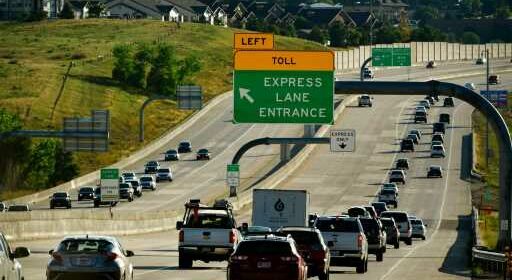C-470 express lane use lags, prompting $4 million loan to cover costs

The Colorado Department of Transportation plans to float its tolling oversight arm a $4 million loan to cover revenue shortfalls in the next year from lower-than-expected use of C-470’s express lanes.
The money will cover a projected $3.7 million in excess costs to operate and maintain the express lanes through June 2024, according to documents prepared ahead of a Transportation Commission vote later this week to finalize the arrangement. Those toll lanes opened west of Interstate 25 nearly three years ago — early in the pandemic — as part of a $276 million expansion of C-470 through south suburban Denver communities.
Changes in traffic and commuting patterns, especially among office workers who now are more likely to work from home, have kept the C-470 express lanes from hitting usage and revenue projections.
The Denver Post reported last year that C-470’s express lanes were among those most heavily affected by the pandemic, while traffic — and toll revenue — had recovered much more quickly along toll corridors on I-25 in the northern suburbs.
C-470’s express lane usage has grown significantly. But tolls and fines brought in roughly $1 million a month in the last year — well short of the $1.5 million level forecast for the corridor’s third year of operation.
“We’re OK on debt (payments). It’s just that we’re not hitting the pledged revenues for all our obligations,” said Nick Farber, the outgoing director of the Colorado Transportation Investment Office (CTIO). The CDOT enterprise arm oversees a growing express-lane network.
Though CTIO and CDOT characterize the new assistance as a “backup loan,” it’s needed to keep the state from violating the terms of a federal loan and revenue bonds that financed about half of the C-470 project’s cost. Lower-than-expected toll revenue has kept CTIO from meeting their expense-coverage requirements, Farber said.
Until now, CTIO’s project reserve and surplus accounts have covered expense gaps, but the surplus balance is now just $1.2 million.
The loan is up for approval by CTIO’s board on Wednesday and then the Transportation Commission on Thursday. It’s an interest-only loan that carries a 3.5% annual rate until payment comes due in 40 years, though early repayment is possible.
CDOT spokesman Matt Inzeo said no other express-lane corridors overseen by the state directly were in need of similar bailouts.
The pandemic also has scrambled the financial picture for Plenary Roads Denver, a private CDOT partner that manages commuting-heavy express lanes along U.S. 36 that connect to downtown via I-25.
Recent financial disclosures show Plenary still was operating in the red during the first three months of 2023. Fitch Ratings has maintained a stable outlook on its project debt, though.
“Plenary Roads Denver continues to meet its loan agreements despite a drop in express lane traffic along US 36 and I-25 Central since 2021,” spokesman Gil Rudawsky wrote Monday in a statement to The Post.
As for C-470, it’s uncertain whether the corridor will need more assistance a year from now.
A contractor soon will start work on a new traffic and revenue forecast geared toward understanding the new normal. And a planned upgrade of tolling equipment that’s expected to result in fewer missed vehicles could buttress revenue, as could an upcoming express-lane safety enforcement program.
Also, tolls are likely going up. CTIO’s board on Wednesday is set to consider annual toll rate increases, based on inflation and operating cost increases, that average 5.6% on C-470 and would take effect Aug. 1. Bumps would range from 5 to 20 cents per zone, depending on the time of day.
Farber says the C-470 express lanes, which he drives on most days, are getting “a decent amount” of use, and he thinks their value will be borne out.
“It’s my belief traffic will come back over time. … We’re just in a different world than we thought we would be back in 2016,” when construction began.
Get more Colorado news by signing up for our Mile High Roundup email newsletter.
Source: Read Full Article